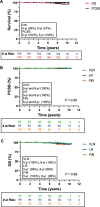Long-term Clinical Outcomes in Favorable Risk Prostate Cancer Patients Receiving Proton Beam Therapy
- PMID: 35530185
- PMCID: PMC9009454
- DOI: 10.14338/IJPT-21-00016
Long-term Clinical Outcomes in Favorable Risk Prostate Cancer Patients Receiving Proton Beam Therapy
Abstract
Purpose: Long-term data regarding the disease control outcomes of proton beam therapy (PBT) for patients with favorable risk intact prostate cancer (PC) are limited. Herein, we report our institution's long-term disease control outcomes in PC patients with clinically localized disease who received PBT as primary treatment.
Methods: One hundred sixty-six favorable risk PC patients who received definitive PBT to the prostate gland at our institution from 2010 to 2012 were retrospectively assessed. The outcomes studied were biochemical failure-free survival (BFFS), biochemical failure, local failure, regional failure, distant failure, PC-specific survival, and overall survival. Patterns of failure were also analyzed. Multivariate Cox proportional hazards modeling was used to estimate independent predictors of BFFS.
Results: The median length of follow-up was 8.3 years (range, 1.2-10.5 years). The majority of patients had low-risk disease (58%, n = 96), with a median age of 64 years at the onset of treatment. Of 166 treated men, 13 (7.8%), 8 (4.8%), 2 (1.2%) patient(s) experienced biochemical failure, local failure, regional failure, respectively. Regional failure was seen in an obturator lymph node in 1 patient and the external iliac lymph nodes in the other. None of the patients experienced distant failure. There were 5 (3.0%) deaths, none of which were due to PC. The 5- and 8-year BFFS rate were 97% and 92%, respectively. None of the clinical disease characteristics or treatment-related factors assessed were associated with BFFS on multivariate Cox proportional hazards modeling (all P > .05).
Conclusion: Disease control rates reported in our assessment of PBT were similar to those reported in previous clinically localized intact PC analyses, which used intensity-modulated radiotherapy, three-dimensional conformal radiotherapy, or radical prostatectomy as definitive therapy. In addition, BFFS rates were similar, if not improved, to previous PBT studies.
Keywords: prostate cancer; proton beam therapy; radiotherapy.
©Copyright 2021 The Author(s).
Conflict of interest statement
Conflicts of Interest: John P. Christodouleas, MD, MPH reports employee status at Elekta, Inc., and grant funding unrelated to this work from Merck & Co., Inc. Neha Vapiwala, MD is an Associate Editor of the International Journal of Particle Therapy. The authors have no additional relevant conflicts of interest to disclose.
Figures



References
-
- Siegel RL, Miller KD, Jemal A. Cancer statistics, 2019. CA Cancer J Clin . 2019;69:7–34. - PubMed
-
- D'Amico AV, Whittington R, Malkowicz SB, Cote K, Loffredo M, Schultz D, Chen MH, Tomaszewski JE, Renshaw AA, Wein A, Richie JP. Biochemical outcome after radical prostatectomy or external beam radiation therapy for patients with clinically localized prostate carcinoma in the prostate specific antigen era. Cancer . 2002;95:281–6. - PubMed
-
- Freedman-Cass D, Shead DA, Schaeffer E, Antonarakis ES, Armstrong AJ, Bekelman JE, Cheng H, Victor AD, Davis BJ, Desai N, Dorff T, Eastham JA, Farrington TA, Gao X, Mark Horwitz E, Ippolito JE, Kuettel MR, Lang JM, McKay R, McKenney J, Netto G, Penson DF, Pow-Sang JM, Reiter R, Richey S, Jude S, Roach M, Rosenfeld S, Shabsigh A, Spratt DE, Teply BA, Tward J. NCCN guidelines version 2.2021 prostate cancer; 2021. National Comprehensive Cancer Network Accessed Mo D Yr. https://www.nccn.org/guidelines/guidelines-process/transparency-process-... . - PubMed
-
- Klotz L. Active Surveillance for Intermediate Risk Prostate Cancer. Curr Urol Rep . 2017;18:1–6. - PubMed
LinkOut - more resources
Full Text Sources
